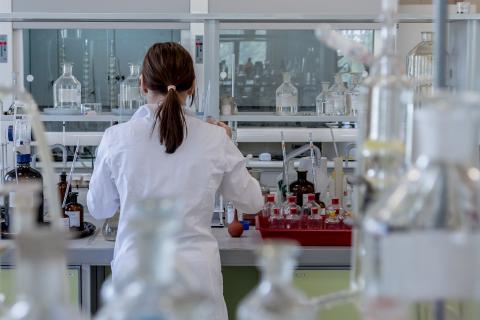
SARS2BlockEntry: using proteins to prevent the virus from entering cells.
The Flash Covid-19 call by the National Research Agency’s (ANR) resulted in the launch of many projects to study and combat the Covid-19 pandemic. The SARS2BlockEntry project, led by Bernard Delmas from the Laboratory of Virology and Molecular Immunology (VIM - Université Paris-Saclay, UVSQ, INRAE), is one of the selected projects.
The objective of the project is to build "nano-ligands" capable of inhibiting or blocking the entry of SARS-CoV-2 into target cells. The work should lead to the development of antiviral drugs targeting Covid-19.
Using proteins to block virus receptors
The Laboratory of Virology and Molecular Immunology specialises in the study of pathogens for use in animal and human health. Several teams, including Bernard Delmas, work on respiratory viruses: influenza viruses which cause the flu and the respiratory syncytial virus (RSV) which causes bronchiolitis. "This new virus, SARS-CoV-2, is a respiratory tropism. We have already worked on other veterinary-linked coronaviruses and the entry of such viruses into target cells, so we thought we could advance the research," explains Bernard Delmas, leader of the SARSBlockEntry project.
The project is based on the development of two types of ligands: camelid antibodies called VHH, and artificial proteins called alphaRep. The objective is to select nano-ligands capable of recognising and blocking a specific domain in a virus protein: the receptor-binding domain (RBD) of the spike. The spikes are envelope proteins. They are what makes the coronavirus look like a crown, which is where the name comes from. This particular spike domain allows the virus to bind with specific host cells. By interacting with a receptor on the surface of target cells, the angiotensin converting enzyme 2 (ACE2), the domain plays a crucial role in infection and the entry of the virus into target cells.
Laboratories working together
The researchers are attempting to using nano-ligands to prevent the virus entering. They will conduct experiments both in vitro experiments (in cell cultures) and in vivo (in a mouse infection model).
Work is already underway. The first step is to produce the RBD so that it can be used to select specific nano-ligands.
“Specific VHH screening will be conducted at the laboratory for Architecture and Function of Biological Macromolecules (AFMB - Université Aix-Marseille, CNRS) by Alain Roussel’s team. AlphaRep screening is being entrusted to Philippe Minard’s team at the Institute of Integrative Biology of the Cell (I2BC - Université Paris-Saclay, CEA, CNRS). In vivo experiments will be conducted at the Maisons-Alfort veterinary school by Sophie le Poder, professor of virology. Selection should begin within a month and we hope to have the nano-ligands relatively quickly," explains Bernard Delmas.
The laboratory and coronavirus: a long common past
Studying the coronavirus spike is not new to Bernard Delmas. He worked for over 10 years on a coronavirus for veterinary purposes, the transmissible gastroenteritis virus in piglets (TGEV). The team, then led by Hubert Laude, characterised the antigenic structure of the spike and attempted to understand how it interacts with its receptor.
"Our past coronavirus work at the laboratory gave us a head start with this project," concludes Bernard Delmas.
